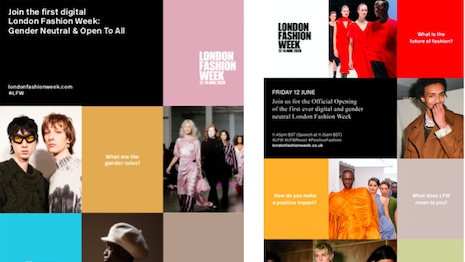
Dior's new 2021 cruise show was watched by thousands during a livestream. Image credit: Dior
By Mickey Alam Khan
When the coronavirus pandemic suddenly and swiftly halted business as usual, it also upended the traditional and venerable fashion calendar — forcing major fashion weeks to go to digital.
Fashionbi’s “Digital Fashion Weeks” report analyzed the strategies, viewership and engagement of fashion brands participating in these digital events. While many luxury brands have grown more accustomed to sharing fashion week content on social media platforms, this was an unprecedented and relatively sudden move in favor of digital, as well as hybrid, events.
“To be honest, during this first digital fashion week there were no true innovations in terms of technology,” said Yana Bushmeleva, chief operating officer at Fashionbi, Milan. “The offline activities were just shown via videos.
“Maybe the brands did not have enough time to prepare something ‘wow,’” she said.
Digital fashion weeks
Although lockdowns were imposed in Europe and the United States starting in mid-March, digital fashion weeks began in earnest this summer.
In June, the British Fashion Council debuted its first all-digital, gender-neutral London Fashion Week with creative help from Wednesday Agency. The digital LFW consisted of interviews, podcasts, webinars and digital showrooms (see story).
That same month, the Fédération de la Haute Couture et de la Mode picked Launchmetrics to digitize its virtual Haute Couture Week and Paris Fashion Week Men’s edition. The two events, held in July, served as a test run for Launchmetrics’ newly developed digital hub (see story).
 London Fashion Week debuted its first all-digital, gender-neutral event. Image courtesy of Wednesday Agency
London Fashion Week debuted its first all-digital, gender-neutral event. Image courtesy of Wednesday Agency
The upcoming iteration of New York Fashion Week, running Sept. 13-17, will feature a combination of live and virtual fashion shows, presentations and other programming.
More than half of the brands that participated in digital fashion weeks shared livestreams on various social media channels. In reality, these “livestreams” encompassed several types of content, including pre-recorded videos and live runway shows, and many brands simulcasted on multiple platforms, expanding their reach.
Of the 47 brands that Fashionbi analyzed, 24 did public livestreams for their runway shows or presentations. All but 5 brands chose Instagram as at least one of their social media platforms to live stream.
“Some of the brands did a live stream on Youtube and not on Twitter, others did on all 4 channels: Twitter, Instagram, Facebook and YouTube,” Ms. Bushmeleva said. “Many did a livestream only on Instagram.”
Luxury brands embraced different strategies during digital fashion weeks.
 The story of the new collection by Louis Vuitton men’s artistic director Virgil Abloh is recounted in an animated film in which characters arrive in Paris during Fashion Week. Image courtesy of Louis Vuitton
The story of the new collection by Louis Vuitton men’s artistic director Virgil Abloh is recounted in an animated film in which characters arrive in Paris during Fashion Week. Image courtesy of Louis Vuitton
As restrictions began lifting in Italy and France, some fashion labels, including Balmain and Dior (
see story), held “socially distant” physical shows that were live streamed on various platforms. In July, Louis Vuitton teased its men’s show with a short animated film during Paris Fashion Week (
see story), and eventually did a live physical show in Shanghai in August.
In contrast, Spanish fashion house Loewe shared a 24 hour livestream, presenting fresh content every hour. However, this approach may have diluted viewership over the course of the event.
Gucci’s co-ed collection was presented during a 12-hour livestream across social media channels, including Western and Asian platforms. Among Western social media, viewership peaked on Twitter with 8.6 thousand viewers compared to 15.6 million live viewers on Weibo.
“[Loewe] did a marathon of presentations, concerts, interviews and masterclasses; it was the longest fashion livestream which lasted 24 hours,” Ms. Bushmeleva said. “Gucci also did a 12-hours livestream, but opposite to Loewe, it looked more like a backstage sneak peek of the campaign shooting.”
Across Western social media channels, Instagram had the highest number of livestream views. Dior’s spring/summer 2021 men’s collection peaked with 16.5 thousand views.
The French fashion label was responsible for the most-viewed shows on three of the four platforms. The Dior cruise 2021 also had the highest views on Facebook and YouTube, peaking at 15.5 thousand and 3.6 thousand views respectively.
On Twitter, Louis Vuitton’s spring summer men’s collection, presented in Shanghai, led the way with 11.9 thousand views at its peak.
Views were significantly higher on Asian social media channels, particularly Weibo. The aforementioned Louis Vuitton show reached 1.8 million peak viewers on Weibo, while Gucci’s Epilogue show peaked with 1.5 million views.
However, focusing on viewership does not offer a complete story on live-streamed shows.
According to Fashionbi, none of the brands achieved an engagement rate close to 1 percent when comparing the number of live viewers to total followers on each social network. This despite brands including Hermès, Louis Vuitton and Gucci investing in sponsored Instagram posts and Stories ahead of their digital events.
YouTube achieved the highest engagement rate, at 0.51 percent, although it did reach the fewest number of subscribers or followers.
Calendar disruption?
Looking ahead, fashion weeks and other hallmarks of the industry calendar will likely continue to be disrupted.
In May, Gucci announced plans to break the fashion industry’s longstanding seasonal calendar and instead hold two shows per year. Creative director Alessandro Michele opined via the brand’s official Instagram that the terms “Cruise, Pre-Spring, Pre-Autumn, Spring/ Summer, Autumn/Winter” were “labels of an impersonal discourse that lost its meaning” (
see story).
New York-based designer Michael Kors, whose self-named company is part of Capri Holdings, said he will not present his fashion show during New York Fashion Week in September. Instead, the brand’s spring/summer 2021 Michael Kors Collection will be presented between mid-October and mid-November 2020, with a format that is work in progress (
see story).
It should be expected that digital components will be part of these upcoming shows.
“The digital is not a trend; it’s our present and future,” Fashionbi’s Ms. Bushmeleva said. “I personally expect more innovation and real digital/omni experience.
“Maybe some elements of augmented reality when you can watch the fashion show live and virtually try the outfits or program your personal avatar instead of a model,” she said. “Something that can immerse the viewer inside the show, turn him from the passive viewer into an active participant.”
 Dior's new 2021 cruise show was watched by thousands during a livestream. Image credit: Dior
Dior's new 2021 cruise show was watched by thousands during a livestream. Image credit: Dior
 London Fashion Week debuted its first all-digital, gender-neutral event. Image courtesy of Wednesday Agency
London Fashion Week debuted its first all-digital, gender-neutral event. Image courtesy of Wednesday Agency The story of the new collection by Louis Vuitton men’s artistic director Virgil Abloh is recounted in an animated film in which characters arrive in Paris during Fashion Week. Image courtesy of Louis Vuitton
The story of the new collection by Louis Vuitton men’s artistic director Virgil Abloh is recounted in an animated film in which characters arrive in Paris during Fashion Week. Image courtesy of Louis Vuitton